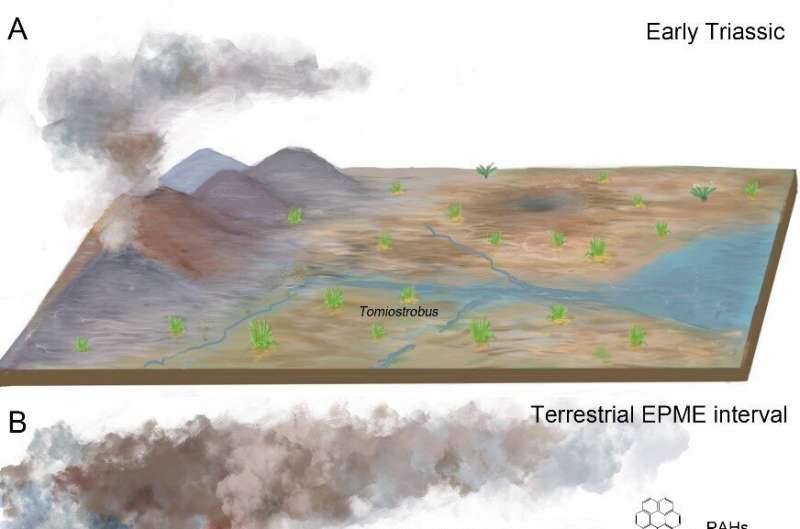This article has been reviewed according to Science X's editorial process and policies. Editors have highlighted the following attributes while ensuring the content's credibility:
fact-checked
peer-reviewed publication
trusted source
proofread
High-temperature wildfire during end-Permian caused collapse of tropical rainforest ecosystems, suggests study

The end-Permian mass extinction (EPME) that occurred ~252 million years ago was the most severe extinction event of the Phanerozoic, devastating both marine and terrestrial ecosystems, with the loss of ~81% and ~89% marine and terrestrial species, respectively.
Recently, a joint research group from the Nanjing Institute of Geology and Paleontology of the Chinese Academy of Sciences (NIGAPS), Nanjing University and Yunnan University has confirmed large-scale high-temperature wildfire combustion events through high-precision organic geochemical analysis of biomarker compounds polycyclic aromatic hydrocarbons (PAHs), which provides insights into the collapse of terrestrial ecosystems and the changeover of vegetation during the Permian-Triassic (P-T) transition period.
The results were published in Earth and Planetary Science Letters.
Intensive volcanic activities around the Siberian Traps large igneous province and large-scale continental arc have triggered massive release of greenhouse and poisonous gases, global warming, aridification and frequent wildfires. The abundance of PAHs, which can be important indicators for incomplete combustion of organic matter formed at higher temperatures caused by wildfires, is a well-known alternative for investigating wildfire activities in geological history.
Most of the previous research on PAHs focused on marine records during the P-T transition period, and research on terrestrial records were relatively insufficient.
This study focused on the high-resolution PAHs in a non-marine P-T transitional sequence from the HK-1 drill core at the Lengqinggou section in Southwest China. The PAHs content showed consistent significant enrichment during the P-T transitional period, which was coupled with negative organic carbon isotope anomalies, revealing that there were large-scale high-temperature wildfire combustion events under the high-temperature and arid paleoclimate conditions during this period.
Additionally, low-molecular-weight compounds such as Dibenzofuran (DBF) were mainly derived from the biodegradation of terrestrial plant polysaccharides and lignin. In the HK-1 drill core, the abnormally high concentration of DBF compounds and the co-variation with the combustion-derived PAHs indicated that the PAHs were mainly derived from high-temperature wildfire combustion of terrestrial plants and the tropical rainforest vegetation systems provided sufficient fuel for large-scale wildfires during P-T transition.
The low PAH contents in the Lower Triassic indicated a fuel shortage after the mass deforestation. The significantly changed PAH ratios showed that the terrestrial ecosystem was greatly affected after the EPME.
These PAH records suggested the vegetation type changed from a dense and highly diverse gigantopterid-dominated tropical rainforest ecosystem to an isoetalean-dominated herbaceous heathland-like ecosystem.
More information: Shenglin Jiao et al, Collapse of tropical rainforest ecosystems caused by high-temperature wildfires during the end-Permian mass extinction, Earth and Planetary Science Letters (2023). DOI: 10.1016/j.epsl.2023.118193
Journal information: Earth and Planetary Science Letters
Provided by Chinese Academy of Sciences





















